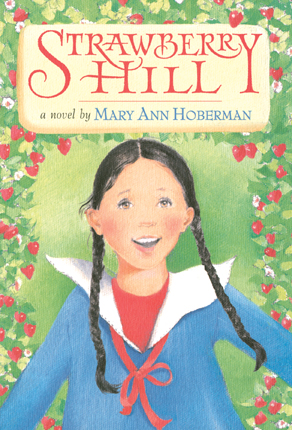Full Text Reviews: Booklist - 06/01/2009 *Starred Review* After someone has written for 50 years and won a National Book Award, it is hard to think of her as a debut novelist. Along with the You Read to Me, I’ll Read to You series, Hoberman is well known for her poetry (and was recently named Children’s Poet Laureate). This is, however, Hoberman’s first work of fiction. Set during the Depression, the result is a small yet highly evocative story that shows that while details may differ, issues of childhood remain the same. Ten-year-old Allie is not pleased that her family is moving, but when she learns that her new street is named Strawberry Hill, it stirs something inside her. Alas, there are no strawberries, but Allie does find friendships and hardships and her first brush with anti-Semitism when a girl calls her a “dirty Jew.” One of the best things about this is Allie’s narrative style. Written in first-person, it nonetheless seems a bit removed, giving readers space to make up their own minds about events. For instance, Allie’s incensed mother makes a scene about the invective, while her father wants to shrug it off (though he tells Allie she should inform her tormentor that Jesus was a Jew). Who is right? With story lines that are simple but never simplistic and perfectly crafted chapters in which the ordinary has the opportunity to become special, this is reminiscent of books by Elizabeth Enright and Sydney Taylor. To be illustrated. - Copyright 2009 Booklist. School Library Journal - 07/01/2009 Gr 3-5 –When the Great Depression hits, 10-year-old Allie Sherman’s family moves from New Haven to Stamford, CT, where her father has found a job. Once there, she meets Martha, who attends the local parochial school and warns Allie about Mimi, the “crybaby” across the street whose father is a “bookie.” While Martha spends time with her friend Cynthia, Allie befriends Mimi. By the novel’s end Allie learns what makes a true friend when she realizes that friendship with Martha will always be limited since she is willing to accept Cynthia’s cheating and mean-spiritedness. Allie also comes to realize that people can change, even adults. The story comes full circle with a satisfying, generally plausible conclusion as summer is about to begin again. Rich details bring the period to life, from books shared to the nauseating Lucky Strike cigarettes smoked by adults. This is a gentle story with the sensibility of a novel written in an earlier time. Characters are well presented, and secondary figures have telling details. For example, Allie’s mother responds quickly and angrily when her child is called a “dirty Jew” by Martha’s friend, though it causes an argument with her husband. This can be read independently or shared as a read-aloud.–Maria B. Salvadore, formerly at Washington DC Public Library - Copyright 2009 Publishers Weekly, Library Journal and/or School Library Journal used with permission. Bulletin for the Center... - 10/01/2009 Though uncertain about moving, ten-year-old Allie Sherman is initially enchanted by her new address, 12 Strawberry Hill, picturing the family’s new rental home as a bucolic strawberry paradise amid Depression-era Connecticut. Though the image proves false, Allie quickly finds a friend in Martha, the girl next door, and possibly another in Mimi, the sad chubby girl across the street. As summer progresses and fourth grade begins, Allie struggles with issues of friendship (Martha or Mimi for best friend?), a first crush, and a convenient case of measles (they allow her to bow out of a disastrous tap class). Jewish Allie also gets her first bitter taste of anti-Semitism in the form of Martha’s snobby Catholic school friend, Cynthia, causing Allie to ask herself “why I still wanted to be best friends with someone who still wanted to be best friends with Cynthia.” Poet Hoberman’s debut novel, inspired, according to flap copy, by her own youthful experience, is a pleasantly nostalgic read, but it also manages to be surprisingly contemporary and very effective in its handling of middle-grade relationships. Allie’s struggles with the bestowing of the “best friend” title will ring true with kids, as will Allie’s continued (though more casual) friendship with Martha after her big change of heart. The adults, too, are engaging and complex, especially Allie’s and Mimi’s very different mothers. Careful soft shading and simple compositions give Halperin’s gentle monochromatic drawings a delicate yet homey appeal. Hand this to mother-daughter book clubs, fans of the American Girls series or the Betsy-Tacy books, and anyone else who wants a tasty historical slice of middle-grade feminine life. JH - Copyright 2009 The Board of Trustees of the University of Illinois. Loading...
|



